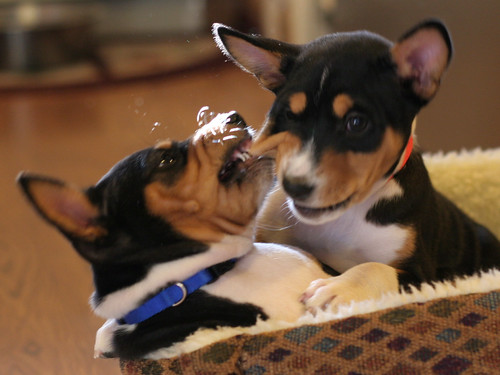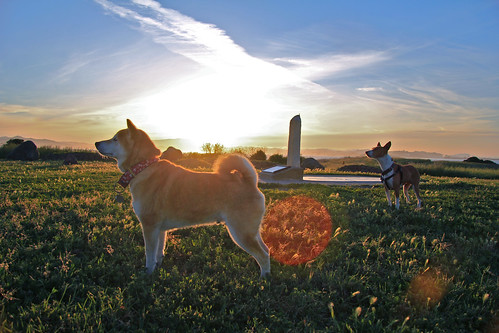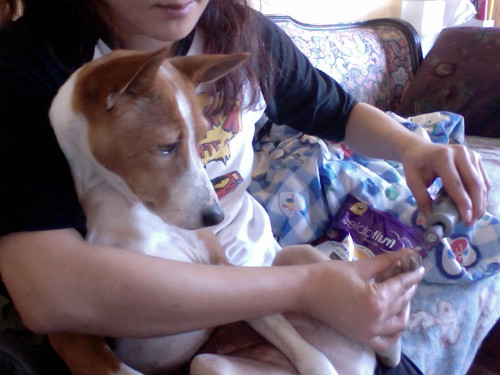About five months ago, I was invited to meet a local breeder’s litter of six-week-old, tri-colored Basenji puppies. None of the puppies were for me, and I was not on the waiting list. The breeder, whom I had gotten to know on the Basenji Forums, aimed to socialize the pups with as many visitors as possible, and was willing to let me sample the Basenji puppyhood that I had missed since Bowpi came to us as an adult from unknown sources.

one with a flipped-up ear is hiding in the middle
It was all I could do to contain my girlish squeals and tears of delight when all six puppies came marching up to greet me at the baby gated foyer. Though I was eager to dive into that puppy pit, entering the home was a challenge with the black swarm underfoot. It was like tiptoeing through bouncing water balloons! Popping a puppy right at the outset would surely have made a bad first impression. I know I made at least one squeak as I gingerly waded through the living room into the open backyard.
Apparently I was forgiven because they were still willing to play with me. Or maybe I was being punished for the offense with puppy fangs. At any rate, they bit and chewed me, the toy I brought, the backyard plants, and each other without compunction. I still trail a few shredded threads from the clothes I wore that day as a souvenir.




There’s no mistaking the fact that these are mouthy puppies, and that they explore the world with their teeth!

Momma and auntie (not father) were both on the premises to correct them as necessary. I got the sense that this was a constant, exhausting task…


These puppies might have added a few extra wrinkles to her brow… and they’re not even hers!
For all my idealism about how responsible breeders should be breeding, raising, placing, and following through with their puppies, this was the first time I’d met a litter that, in my opinion, was being done “right.” We chatted for a good portion of the afternoon about puppies, the breed, and more, until the entire litter was knocked senseless by our blather.

One thing that left an impression on me was how eager every puppy was to see who was at the door. When the breeder and I talked about this, she made an astute point that the Basenji reputation for being “independent” and “aloof” applies to mature adults — not developing puppies. An aloof adult raises little concern, but puppies should be sociable, curious, and brimming with confidence to accept new experiences. They weren’t necessarily ready to climb into my lap and would sooner chew than cuddle me, but they were evidently unfazed by my presence and ready to engage.
All this resonated with me, especially since these descriptors — aloof, independent, standoffish, not cuddly, etc. — have commonly been used to describe, and excuse, Shibas for being Shibas. It made me recall how we selected Bowdu in the first place. Of all the puppies in the bin, he was the only one sitting apart and watching from a corner. He didn’t appear fearful, but he had no interest in joining the puppy games; when a Golden pup tumbled into his corner, Bowdu nonchalantly extended a paw to hold the pup out of his space.
And we laughed and were charmed and chose him.
The night we brought Bowdu home and put him on the floor of the apartment, it took a brief moment to register that his environment had completely changed from the busy night market that he had known. Then he shuffled underneath the nearest desk and started whimpering. He couldn’t be coaxed out, so after a while, I gently pulled him out… He never tried to hide from us again, and seemed to forget his initial fears, though we would continue to deal with fear-based behaviors for a long, long time.
I doubt Bowdu was well socialized by his breeder or broker, and we didn’t do enough to bombproof him as a puppy. He’s fine now. But for months, and years even, I often excused his quirks as somehow related to either breed temperament or our misanthropic personalities, as his guardians. Oh, he shies away from strangers on the street because he’s being “reserved,” and that gives me an excuse to avoid people, too. He’s cowering from the constant stream of passing scooters because Shibas are highly alert and “sensitive,” and I wouldn’t want him to get too close anyway! He’s frantic and pulling on walks because he’s “stubborn” and “independent-minded” and wants to chart his own course home, even though he has a butt full of poop that should be eliminated outdoors, not on paper.
In my ignorance of dog behavior, my interpretation of those key adjectives in no way matched the spirit by which Shibas are often described. Or Basenjis, for that matter! There were details about Bowdu’s puppy behavior that were really not okay, in retrospect, but my misapplication of supposed breed temperament allowed me to mask, and worse yet, normalize certain kinds of anti-social behavior that really don’t befit the breed.
Bottom line is that my misinterpretation of those terms did not benefit my dog as an individual, over the course of his development.
There have been so many times on my dog forums (moreso Shibas than Basenjis) where someone’s fearful, aloof, non-cuddly puppy behavior is dismissed as somehow “typical” of the breed. Sometimes it’s a new dog owner having to face the crushing disappointment that they’re really not the center of their puppy’s world, and that’s part of the reality of owning a “primitive” breed. Yet other times, behaviors like hiding, running away in fear, a general listlessness and dullness to stimuli are excused as “typical” breed traits by well-intentioned folks who are just trying to reassure the confused dog owner that they did get what they signed on for.
However, so often the conversation is about puppies that have been home for days or just weeks, who haven’t even been alive long enough to develop personal preferences, let alone show stable breed proclivities! They’re still growing into the world. New owners are still learning to observe and describe them as individuals, not against everything they’ve researched about the breed (if at all). Puppies don’t consult the breed manual. And even the stablest pup from the most temperamentally sound parents can develop a mind of her own as an adult; indeed, “independent” is so vague a term here as to be useless.
What I’m saying is that a fearful, dull puppy is not necessarily a final judgment on the breeder, nor does this alone limit the dog’s potential to live up to breed hype. But having now met an entire litter of pups that seemed so alert, resilient, emboldened by adventure, and downright youthful, I am reminded of how childhood and adulthood are fairly demarcated developmental categories. Perhaps it is our anthropomorphic tendency to conflate the two. If so, that is our folly, and the child’s loss — of any animal species.

spoke of how he finds it cruel and freakish to reduce dogs, with their evolutionary history as working animals, to the lazy lifestyles of modern pethood. When you take the “work” away from the working dog, the drive always remains, as a matter of biological coding. Apparently, there’s no such thing as true retirement either when your existence is valued on the basis of your work. Even Coppinger has remained awfully busy as an emeritus professor. Yet I’m keenly aware of his age and accompanying stature because I don’t think he’s allowed his thinking to change much in light of emerging research, scientific and historical.


































